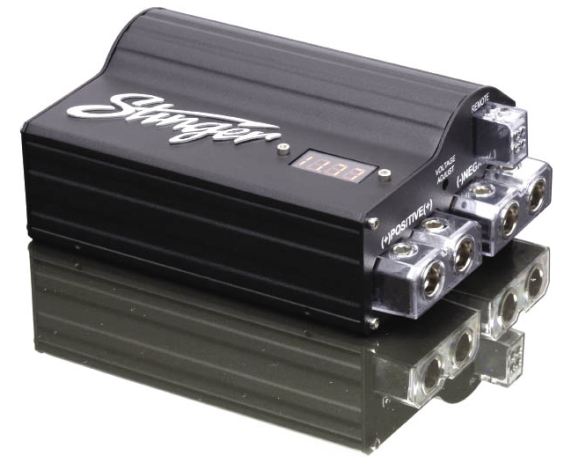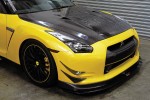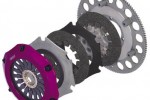For this issue I thought it’d be a good time to review a much misunderstood and much maligned topic, the good old external power supply capacitor, or “Stiffening Cap.” I like the term “stiffening” as that’s exactly what happens, the added current available in the capacitor “stiffens” the supply of current to the amplifier. (The term “Stiffening Capacitor” is a registered trademark of Autosound 2000, and used with kind permission).  Some people will tell you these things are snake oil, and many others swear by them. I have seen the subject of large storage capacitors take up several pages of internet postings, with supporters and detractors split about evenly. I think much of the confusion surrounding capacitors are caused by two things. First, a fundamental misunderstanding of how they work and what their actual benefits are (and aren’t), and second, the amount of substandard, low quality products available at bargain prices that simply doesn’t work and are a waste of money. While high quality caps work well, poor caps can actually make things worse. And unfortunately, it’s difficult to know which are which. Before buying a capacitor, I would always do some research and consider the opinions of others who have used the brand and model before, as well as referencing test reports and trustworthy articles etc. Usually, (but not always) the established brands are generally a very safe bet. Price can also be a guide, as with most high performance parts the cheapest brands are probably not the best performers.
Some people will tell you these things are snake oil, and many others swear by them. I have seen the subject of large storage capacitors take up several pages of internet postings, with supporters and detractors split about evenly. I think much of the confusion surrounding capacitors are caused by two things. First, a fundamental misunderstanding of how they work and what their actual benefits are (and aren’t), and second, the amount of substandard, low quality products available at bargain prices that simply doesn’t work and are a waste of money. While high quality caps work well, poor caps can actually make things worse. And unfortunately, it’s difficult to know which are which. Before buying a capacitor, I would always do some research and consider the opinions of others who have used the brand and model before, as well as referencing test reports and trustworthy articles etc. Usually, (but not always) the established brands are generally a very safe bet. Price can also be a guide, as with most high performance parts the cheapest brands are probably not the best performers.
These devices are not new. Dating back to the 1700’s when they were called Leyden jars, through the early 1900’s when they were referred to as condensers, the electrolytic capacitor is basically a device capable of storing electrical energy. How much energy can be stored, depends on the rating of the capacitor in microfarads (or in the case of big caps in Farads), and the working voltage it’s designed to operate at. Now, getting back to car audio, the energy storage device in a car is the battery. The battery is designed to store enough energy to start the car, at which point the cars alternator becomes the main power source because it provides a higher voltage potential. In a battery, there are typically a bunch of lead-oxide plates immersed in acid. The resultant chemical reaction creates an electrical charge potential or voltage in the battery. However, batteries have fairly high internal resistance, which explains why a charging voltage of over 14 volts is required to maintain a 12 volt battery. An electrolytic capacitor has far greater “plate area” than a typical battery, and as a result has much lower internal resistance. This allows much faster current delivery, without the voltage drop that’s attributed the batteries high internal resistance.
A car stereo amplifier has a switching power supply inside that does not consume power steadily like a light bulb or heating element. Instead, the power supply of a normal car amplifier draws current from the cars electrical system in very rapid pulses, usually in excess of 35,000 times per second. This means that your amplifier needs 35,000 pulses of current per second to reproduce your tunes… Think about that the next time you’re cruising down the street with the tunes fully cranked! Here’s where things get interesting. Suppose you had a device that was capable of supplying hundreds of amperes of current in milliseconds. To accomplish this, it would have to have very low internal resistance and inductance. These specs are referred to as ESR and ESL. Equivalent Series Resistance is usually measured in milliohms, and should be very low if the capacitor is going to be able to work properly. If you connected this device in parallel with the cars battery, and mounted it close to the amplifier to minimize wiring resistance losses, the amplifier would be able to draw all the current it needed, virtually instantly. And that, is exactly what a “Stiffening Cap” does.
Okay, here’s where the confusion seems to start. Most high power amplifiers already contain a certain amount of power supply capacitance, but very few actually have enough to supply the power supply under all conditions. Adding that much internal capacitance would cost a lot of money, as well as make amplifiers quite a bit larger in size. However, back in the 80’s and 90’s I used to make a bit of spending money by upgrading the power supplies in old Fosgate, Linear Power, Phoenix Gold, and Audiomobile amplifiers. These mods absolutely made audible and measurable differences. As with my old modifications, the real and main benefit to using a “Stiffening Cap” is improved sound quality, particularly in brief, high current transients, such as drums and plucked strings. As I mentioned above, if you have a big enough capacitor, (or a small enough amp) you may notice a reduction in the amount of headlight dimming to see when the bass notes hit as well.
Some people say that amplifiers using a “tightly” regulated power supply can’t benefit from a Stiffening Capacitor. That statement is simply nonsensical. Even highly regulated amplifiers still draw current in high frequency pulses, and if the supply of current upstream of the amplifier is too slow, the amplifier will not be able to obtain all the current it needs to reproduce the music properly. Remember, the main function of the Stiffening Cap is to provide very large amounts of current to the amplifier, in a very short period of time. They are not designed to hold the vehicles voltage up at a higher potential, although that can sometimes be an ancillary minor benefit.
Other people say Stiffening Caps are useless in SPL contest vehicles. Again, I would fundamentally disagree. In fact, way back in 1983, Mr. dB Drag Racing himself, Wayne Harris used a large bank of capacitors in his first National Crank-It-Up winning entry. Back then, Harris had to cobble together dozens of smaller value caps to get the total amount of energy storage that you can buy today in a single package, but it was worth it… and he won.
Still others claim they spent a bunch of money and were not able to hear or measure any difference whatsoever. Unfortunately, that is very possible. When these devices were first offered to the car audio industry, they gained wide acceptance and popularity. As with all things, the desire to make a profit reared its head and in an effort to make a buck, some ahem, “less than optimum” product has been produced. But, quality products do exist and they do work! One way to find a quality product is to ask others about what works and doesn’t work for them. Or, you can read test reports and valuable reviews in magazines like this one, and as luck would have it, the good folks at Stinger just sent me two of their big caps to run through the gauntlet in our test lab.
STINGER HYBRID POWER CAPACITORS
The Stinger caps I received are the SPC505 and SPC 5010 models. These are hybrid capacitors and combine a mixture of very high capacitance carbon caps with a normal electrolytic. Using this technology, a very large amount of energy can be stored in a relatively small package. Rated at 5 and 10 Farads respectively, these Stinger capacitors are very large energy storage devices and consequently need to be treated with quite a bit of respect.
Features
The Stinger capacitors are rectangular devices and look sort of like a miniature amplifier. They have large heavy duty double connections that will accept 1/0 wire. The connections are solid brass and nickel plated for impressive good looks and corrosion resistance. When installing any sort of large capacitor, the first thing to double check is that you have the polarity correct. Otherwise, these things and hand grenades might have something in common…
Luckily for us though, the clever folks at Stinger have thought to include a reverse polarity warning buzzer, designed to let you know there is a problem before anything really bad happens. The second thing you ought to know about these big caps, is they charge and discharge incredibly quickly because of their low internal resistance. This means if you connect them directly to the battery wires without slowly charging them first, there is going to be a BIG spark and no doubt some melted wire marks on the pretty nickel plated brass connectors. Use a resistor, or the included light bulb to both charge and discharge the cap. This results in a lot less drama, and prevents you from banging your head on the trunk lid as you run screaming from the install bay.
These impressive Stinger caps also have a cool built in LED readout which shows your battery voltage whenever the system is turned on. These displays are powered separately and it’s recommended you use a relay triggered by the amps turn on lead to supply the 12V power to drive them. This way, the displays go off when the system goes off and don’t draw any current.
Tech
Both of the caps from Stinger are rated for a normal working voltage of 16 volts and a surge voltage of 18 volts. They have very low ESR (Equivalent Series Resistance) and I found that their published specification of 0.0015 ohms was dead on. If the ESR is too high, the ability of the cap to provide any real benefit is greatly reduced, so this is an important spec. I also measured the total capacitance available in each Stinger sample and I’m pleased to report unlike some of the bargain brands out there, these Stinger capacitors actually exceeded their specifications for energy storage. Based on my measurements of both capacitors, the Stinger SPC505 and SPC 5010 are indeed the real deal and should provide a noticeable improvement in sound quality in most systems.
Stinger Electronics
USA: www.stingerelectronics.com
CANADA: www.gentec-intl.com
Related Articles
 PASSWORD: JDM - Dry Carbon GT-R Parts
PASSWORD: JDM - Dry Carbon GT-R Parts
 Project R32: Proper Exedy Racing Clutch Selection
Project R32: Proper Exedy Racing Clutch Selection
 Getting Hyphy: Calvin Wan's 1993 Mazda RX-7
Getting Hyphy: Calvin Wan's 1993 Mazda RX-7
 BIG BALLIN'
BIG BALLIN'
 Rugrat: Sean Driscoll's 2004 Scion xB
Rugrat: Sean Driscoll's 2004 Scion xB
 Project R32: Adjustable Suspension Links
Project R32: Adjustable Suspension Links


